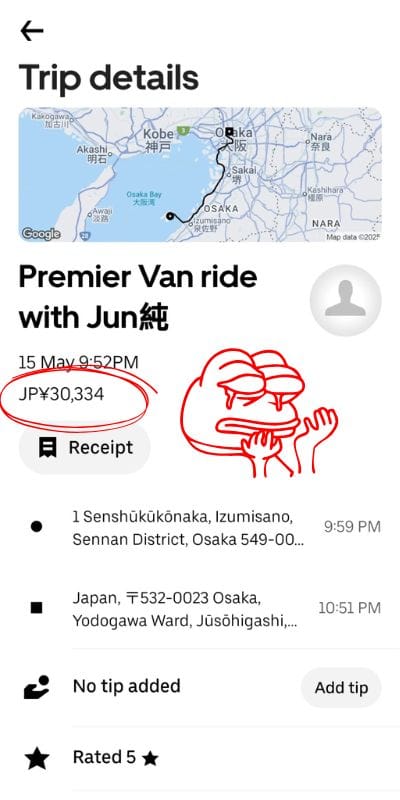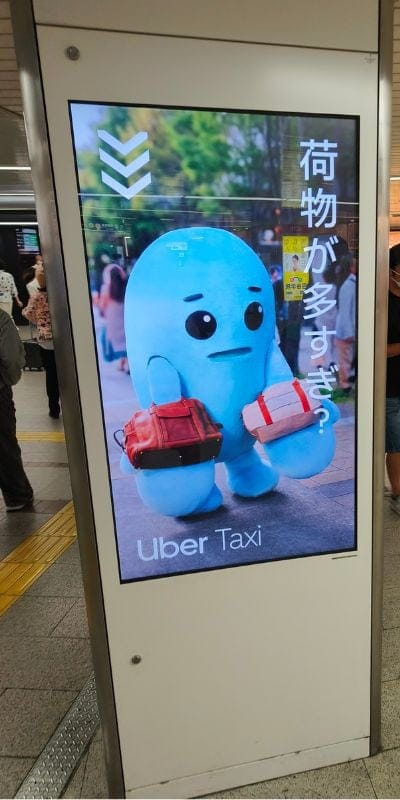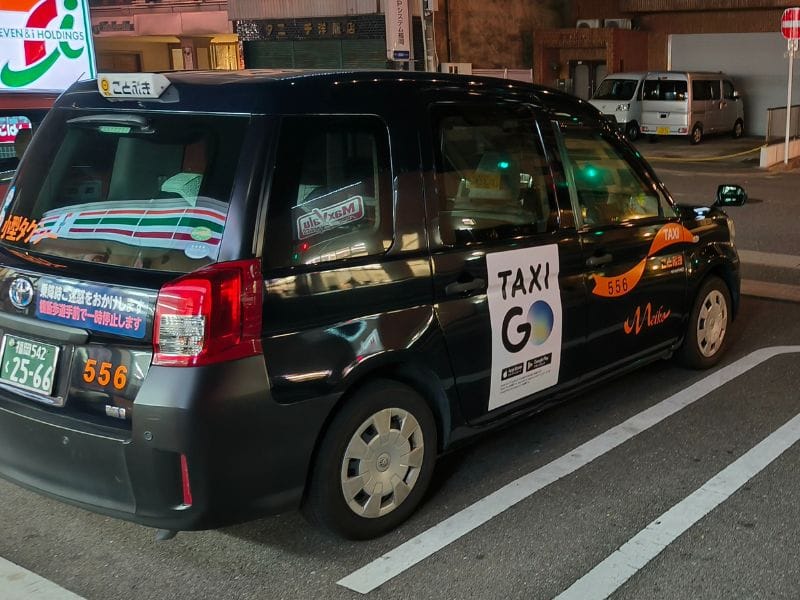This post contains affiliate links. If you make a booking through them, we may earn a small commission at no extra cost to you.
Let’s get straight to the point: Yes, you can use Uber in Japan. The app works. You can open it, book a ride, and a car will show up. But should you? Absolutely not and I’m telling you this so you don’t make the same £150 mistake we did.
We landed in Osaka after a 17-hour journey with four suitcases, three rucksacks, three bits of hand luggage, two moaning overtired kids in tow. And yes, I know how ridiculous that amount of luggage is for a family planning to move city every week.
We made the classic rookie error: we went with what was familiar. The Uber app worked, so we assumed that meant it was the best option or at least an option that wouldn’t rip us off.
As you can see below, It wasn’t.

In this post, I’ll break down exactly what happened, what we wish we’d known, and the much cheaper, easier alternative locals actually use (and that doesn’t involve blindly trusting a £150 price tag just because you recognise the app, like we did above).
Quick tip :
We used a Nomad Japan eSIM for instant data at the airport , Although there is often free Wi-Fi in the airport it doesn’t stretch to outside near the pickup points. So you need data.
Having trouble setting it up – Go to our eSim trouble shooting guide.
Is Uber Available in Japan?
Yes, the same Uber app you already have installed will work in Japan. You don’t need a separate, Japan-specific version. It’ll show you nearby cars, let you order a ride, and work just like back home. You’ll even spot Uber-branded cars and an advertising push around major cities so whilst Uber are clearly making a push to conquer Japan. It’s not going to work without a serious rethink of their pricing.

Why You Probably Shouldn’t Use Uber In Japan
Here’s the part we learned the hard way.
We booked what seemed like a standard Uber from Kansai Airport to our hotel about a 45-minute journey. Nothing unusual.
We didn’t pick a premium vehicle. We didn’t get stuck in traffic. We just ordered what we thought was a normal airport ride.
And it cost us £150.
Why? Because in Japan, there isn’t enough demand to support a standalone Uber driver network so it relies on partnerships with local high-end taxi fleets. That means:
- Higher base fares
- Zero competition pricing
- You’re essentially booking a private hire car through a familiar-looking screen
Our Rookie Mistake: £150 Later…
It was nearly midnight. The airport taxi desks were closed. We were exhausted and just wanted to get to the hotel.
We saw a line of taxis, but after a bit of confused pointing and translating, we figured out they were all pre-booked only. With no way to order one on the spot, I connected to the airport’s free Wi-Fi, opened Uber, and was genuinely relieved it worked.
Until I saw the price. But at that moment, it felt like we didn’t have a choice.
And as our £150 Uber pulled away from the terminal, it drove right past a queue of non-prebooked taxis, lined up and waiting to help families like ours. We just hadn’t walked far enough to see them.
“Moral of the story? Open your eyes easier said than done after 17 hours of travel, two hungry kids, and no sleep“.
A Smarter Alternative: Go Taxi App
If you’re travelling in Japan and want the convenience of app-based taxi booking without the Uber premium.
Download the Go Taxi App for I Phone Here.
Download the Go Taxi App for Android Here.
Go is Japan’s equivalent of Uber except cheaper, more transparent, and fully integrated with the country’s standard taxi system. The app is in English, and it works just like you’d expect:
- Set pickup and drop-off
- Pay via card
- Track your ride in real time
How to Use the Go App in Japan
Here’s how to get started:
- Download the Go Taxi App (App Store or Google Play)
- Enter your pickup and drop-off locations
- Add a credit/debit card
- Confirm your booking
- You’ll see the driver, the vehicle, and the estimated arrival
It’s fast, easy, and essentially the same as Uber.

The Toll Road Trap (Separate to Uber)
This wasn’t part of our original £150 mistake but it’s something you’ll want to be aware of if you’re using Go Taxi.
Later in our trip, we moved hotels across town. When our driver arrived, he asked (very politely) if we wanted to use the “high speed” route to avoid traffic. Sounded fair. I nodded without thinking.
Turns out, “high speed” means toll road, and in Japan, that’s charged per kilometre. I didn’t realise that meant I’d be footing the bill, not the driver. It’s not a scam, just something to be aware of when budgeting.
So if you’re asked about “high speed” routes, know that it’s code for “would you like to get there faster, for a bit more money?”
FAQ: Uber and Taxis in Japan
Do Japanese taxis take credit cards?
Yes, most taxis in major cities like Osaka, Tokyo, and Kyoto accept credit cards. Look for the sign on the window, or ask before jumping in.
Is Uber better than taxis in Japan?
No. It’s usually more expensive, and often uses the same cars you’re just paying more for the same journey. Use Go or grab a taxi from a rank.
Do you tip taxi drivers in Japan?
No, tipping isn’t expected. Just pay the fare and thank your driver with a polite nod or an “arigatou gozaimasu.”
Final Thoughts
Can you use Uber in Japan? Technically yes. But unless you want to hand over £150 like we did, you’ve got better options.
Download Go Taxi. Set up an eSIM. And learn from our jet-lagged, luggage-laden, rookie mistake.
Use your money for better things like ramen, matcha, and those weird but amazing vending machine desserts you’ll pretend to buy “for the kids.”







3 Comments
Comments are closed.